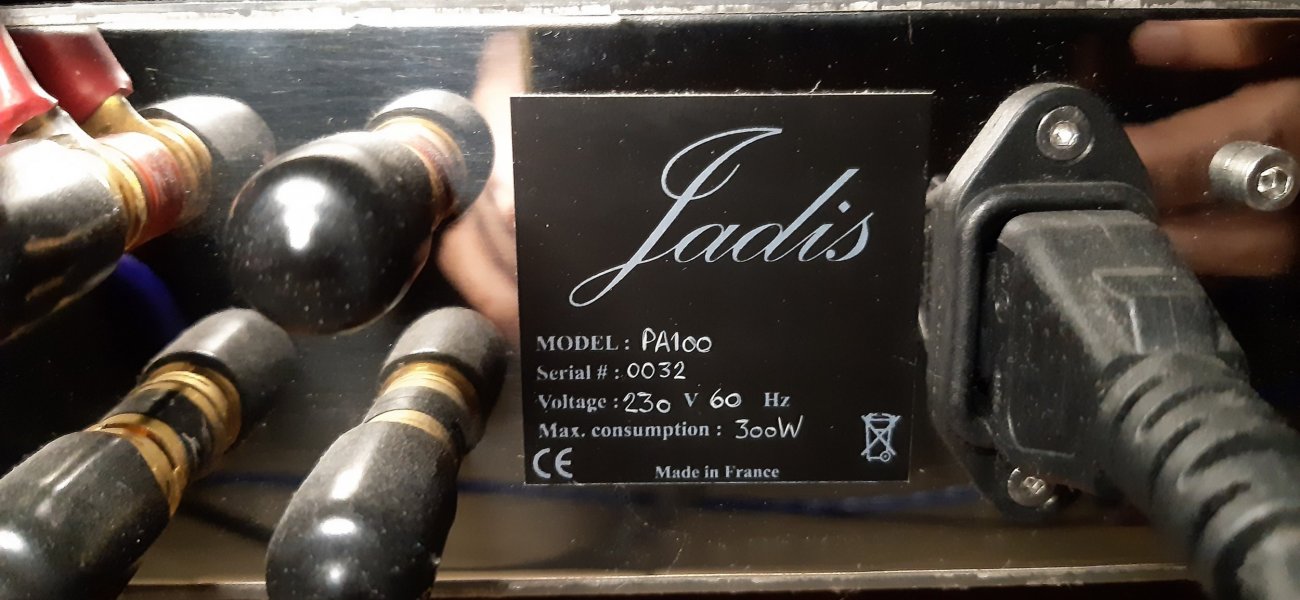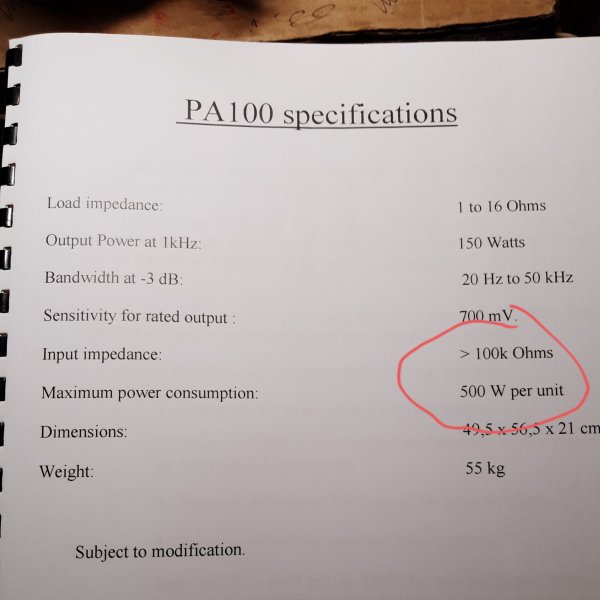From what I was told, only Prima Luna and VAC has the true auto bias circuitry. There will a a light to indicate a bad tube and no need to get a matched pair, just replace bad tube.
Jadis PA 100 amp - Jadis becomes Jadis again
- Thread starter jadis
- Start date
You are using an out of date browser. It may not display this or other websites correctly.
You should upgrade or use an alternative browser.
You should upgrade or use an alternative browser.
I wrote down the numbers that Jadis marked on the stock tubes. It is probably unique in nature that no other tube seller can translate.
In this case, A1 and B1 are the matched pairs, and so on till the 6th matched pair. The manual said that each tube needs to be in its designated socket as shown in a diagram in the owner's manual.
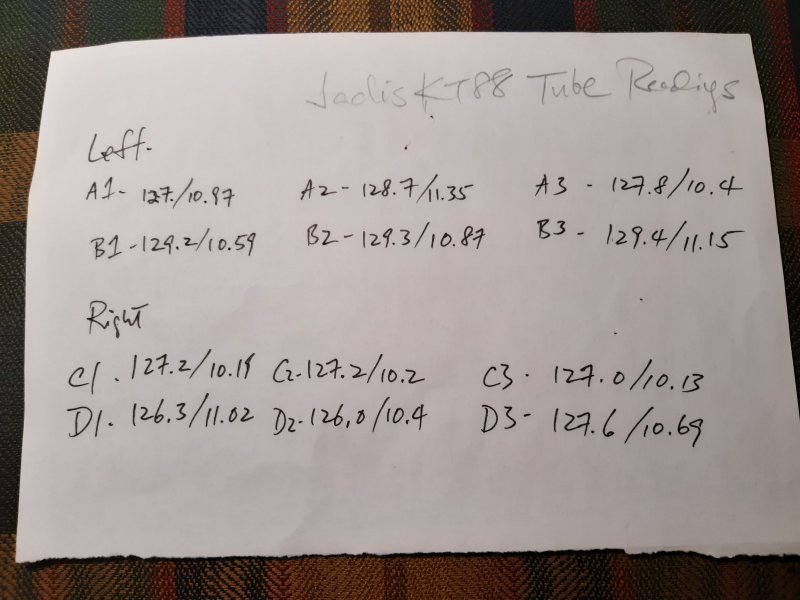
In this case, A1 and B1 are the matched pairs, and so on till the 6th matched pair. The manual said that each tube needs to be in its designated socket as shown in a diagram in the owner's manual.

A manual bias amplifier does not have to have trimpots. Sometimes manufacturer/designer calculates the impedance required for the circuit based on tube’s general characteristics and installs a resistor for each tube instead of an adjustable pot. I believe jadis PA 100 is designed like that. this kind of design is more like a manual bias cause it’s manually set in the factory and you need to change the resistor in order to change the bias. That’s a better approach in terms of purist circuit design but it has a major down side. You need to use perfectly matched pairs or quads that will behave same while they age which is almost impossible to accomplish. Most probably that’s why it has a fuse for each tube. If one of them ages differently and goes bad due to factory set constant bias, it triggers it’s fuse and saves the circuit. IMHO regarding it’s circuit design it can be called constant bias amplifier.
On the other hand a normal manual bias amplifier has pots to adjust bias according to changing conditions such as line voltage, tube age and characteristics.
Auto bias measures cathode current/plate voltage etc and regulates it automatically using a dedicated circuit which I couldn’t see in PA 100.
Addressing the type of amplifier bias just according to the existence of a bias control can be misleading - for example the predecessor of the Jadis PA100, the DA7 (Defy) had a mix of cathode and fixed bias. This article on cathode and fixed bias says most of it.
http://carlscustomamps.com/cathode-vs-fixed-bias
We should remember that cathode bias is also called self bias and fixed bias can be manually adjusted!
From what I was told, only Prima Luna and VAC has the true auto bias circuitry. There will a a light to indicate a bad tube and no need to get a matched pair, just replace bad tube.
The VTL Siegfried amplifiers had true auto bias controlled by a microprocessor . This circuit also makes tubes diagnostics and disconnects a faulty tube before it damages the amplifier.
Some older amplifiers had auto bias using a feedback operational amplifier circuit in an integrator configuration, with a time constant of a few seconds.
Although it is true that many amplifiers strictly do not need tubes with matched plate current, IMHO they should be matched for trans-conductance in push pull pairs. Do we want our sinusoidal signals distorted with one half of it having higher amplitude than the other?
So that's another one. User friendly.The VTL Siegfried amplifiers had true auto bias controlled by a microprocessor . This circuit also makes tubes diagnostics and disconnects a faulty tube before it damages the amplifier.
Some older amplifiers had auto bias using a feedback operational amplifier circuit in an integrator configuration, with a time constant of a few seconds.
Although it is true that many amplifiers strictly do not need tubes with matched plate current, IMHO they should be matched for trans-conductance in push pull pairs. Do we want our sinusoidal signals distorted with one half of it having higher amplitude than the other?
And this it the owner's manual of the ARC REF 110. The measuring and trim pots are INSIDE the chassis. Have to be real careful. I helped a friend install new tubes on it and did what the manual says.
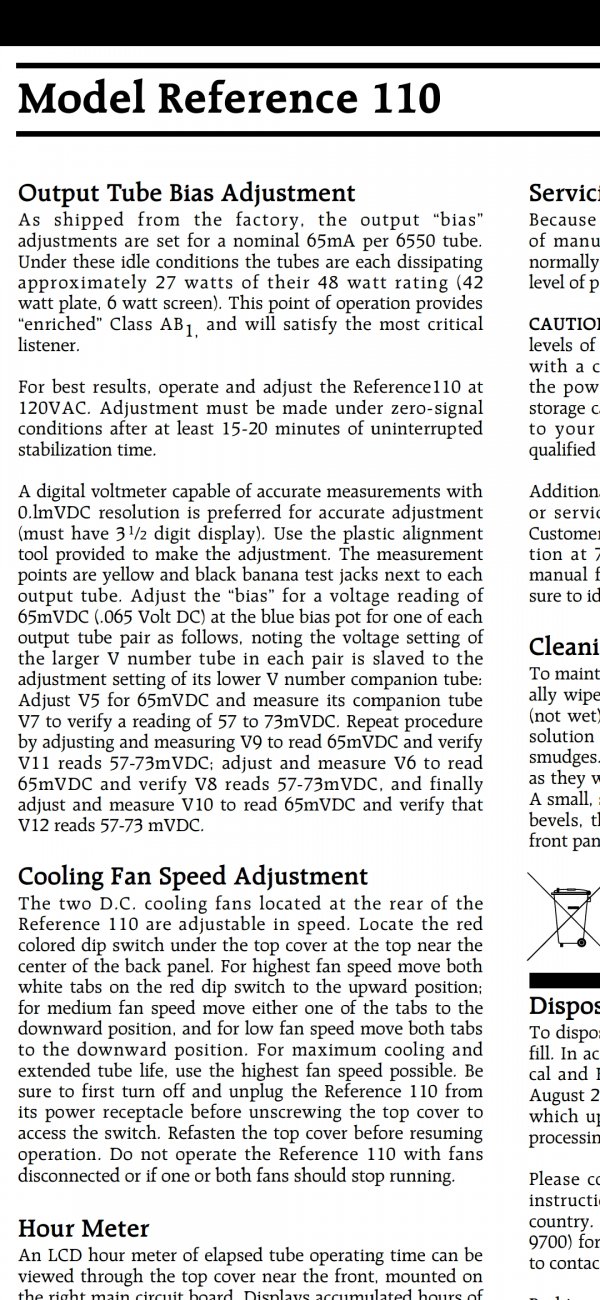
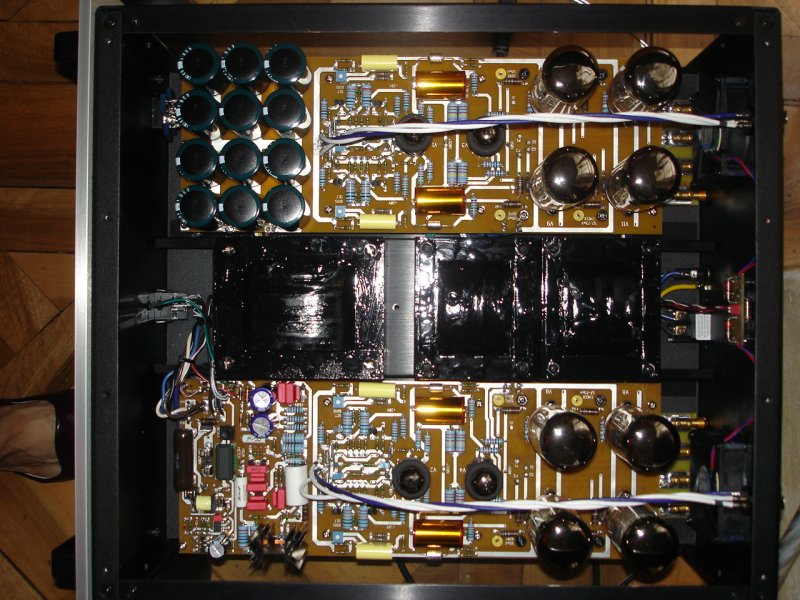
That is what I understand as Manual biasing, or is it cathode or fixed. I'm getting lost in these terms.


That is what I understand as Manual biasing, or is it cathode or fixed. I'm getting lost in these terms.
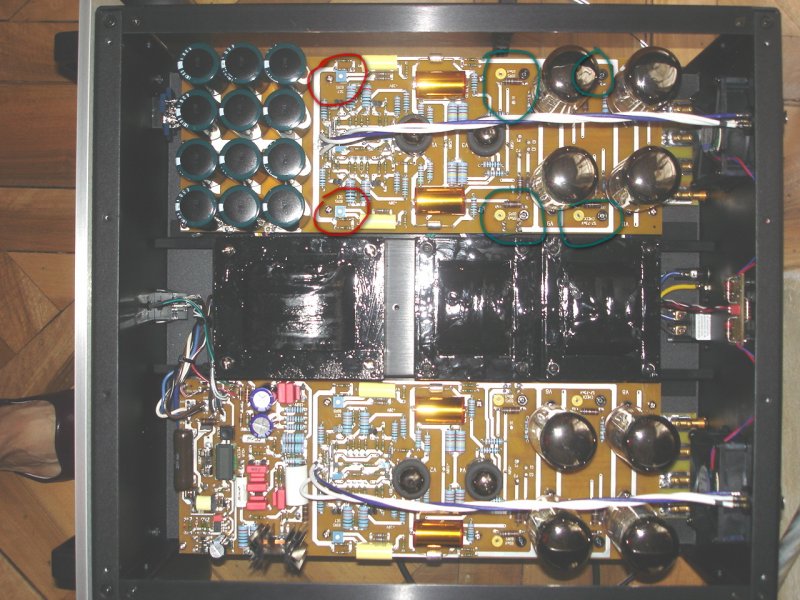
Though I had helped set the bias of this Ref110 in 2007, I forgot a bit where the pots are and I had to brighten it and finally found the yellow and black banana jacks and the blue trimming pots which are situated quite far away from the pair of jacks. And the 'strange' manner of the biasing is that you nailed the first tube at 65mA and it's partner tube had be in the range of 57-73mA. calling that second tube a 'slave'. I really wonder what that does for proper tube life aging when the slave tube is at the extreme values.
I have had 2 ARC amps, VS110 and VS115 pop its biasing resistors, scary, with a bad smell and I had to find the fragment of the burst resistor to clean up. the VS115 even had a bright arcing tube light, no pun intended. I thought the tube was gone but it turned out that both were alive and kicking , only needed a resistor replacement.
Which is why when I wanted to buy the PA100, I had to have the bottom plate opened and I was looking for these banana jacks and trim pots to know if it was a true manual biasing amp. Without these, there is nothing for the owner to do, that simple.
Your most thorough explanation goes in line with folks at the DIY forum regarding biasing of the Jadis Orchestra...Appreciate your reply greatly to say the least!!!!A manual bias amplifier does not have to have trimpots. Sometimes manufacturer/designer calculates the impedance required for the circuit based on tube’s general characteristics and installs a resistor for each tube instead of an adjustable pot. I believe jadis PA 100 is designed like that. this kind of design is more like a manual bias cause it’s manually set in the factory and you need to change the resistor in order to change the bias. That’s a better approach in terms of purist circuit design but it has a major down side. You need to use perfectly matched pairs or quads that will behave same while they age which is almost impossible to accomplish. Most probably that’s why it has a fuse for each tube. If one of them ages differently and goes bad due to factory set constant bias, it triggers it’s fuse and saves the circuit. IMHO regarding it’s circuit design it can be called constant bias amplifier.
On the other hand a normal manual bias amplifier has pots to adjust bias according to changing conditions such as line voltage, tube age and characteristics.
Auto bias measures cathode current/plate voltage etc and regulates it automatically using a dedicated circuit which I couldn’t see in PA 100.
I totally agree on using tubes with matching trans conductance for push pull pairs but also matching plate current makes your life easier. When using strong NOS tubes it may go out of biasing range depending on the biasing circuit design.Although it is true that many amplifiers strictly do not need tubes with matched plate current, IMHO they should be matched for trans-conductance in push pull pairs. Do we want our sinusoidal signals distorted with one half of it having higher amplitude than the other?
I have posted this question in another thread, but still eager to hear inputs on this issue. What if, out of the 6 push pull matched pairs (12 pcs), 1 pair dies and the replacement (in the meantime waiting for new orders to come in) is a pair of used tube but was matched before (same brand)? Or a replacement pair that is brand new but of another brand? Will the sonics be affected or just plain psychological ?
Stumbled into this info re biasing of the VAC amps, it's patented so it should be one of a kind in the industry.
Looking at the patent, https://patents.google.com/patent/US8749310 , we can find it includes a control loop - this could mean some kind of feedback, something that could upset a few WBF members.Stumbled into this info re biasing of the VAC amps, it's patented so it should be one of a kind in the industry.
Anyway their argumentation is based on the claim that variations of 2% bias current are distinctly
audible. Probably some people can notice it , I have not reliably noticed any sound difference in my system with bias variations of +/- 5%.
The thing with tube amps, lovers of it will have to put up with some maintenance issues with it, but mostly it's resistors or the tubes themselves. I heard that some SS amps have to be sent abroad to its manufacturer when any repair is needed. So it's choosing your own poison. 
The issue about auto bias and manual bias is actually not as simple as these 2 words. It's been expanded and further explained into cathode biasing, fixed biasing (that is really variable) , tube's capacity, voltage and a lot of tech babble that the common man cannot comprehend. My first tube amp, the ARC D-115 MK broke down on the first week of purchase (brand new) and the dealer tech man found out 2 driver tubes were noisy and distorting. I almost quit right there and then, but somehow what tube amps can do I find very appealing to keep buying them, to date, I have had the ARC D-125, VTL 120 monos, CJ MV125, Jadis JA200, ARC VS110, ARC VS115, and this present PA100, whose controversial 'Manual' bias in all brochures have created angst and worry among prospects. But amazingly, the Jadis FB group members have never posted any questions and issues on it biasing, or tube replacements. Looks like they're too taken to worry about these things.
The issue about auto bias and manual bias is actually not as simple as these 2 words. It's been expanded and further explained into cathode biasing, fixed biasing (that is really variable) , tube's capacity, voltage and a lot of tech babble that the common man cannot comprehend. My first tube amp, the ARC D-115 MK broke down on the first week of purchase (brand new) and the dealer tech man found out 2 driver tubes were noisy and distorting. I almost quit right there and then, but somehow what tube amps can do I find very appealing to keep buying them, to date, I have had the ARC D-125, VTL 120 monos, CJ MV125, Jadis JA200, ARC VS110, ARC VS115, and this present PA100, whose controversial 'Manual' bias in all brochures have created angst and worry among prospects. But amazingly, the Jadis FB group members have never posted any questions and issues on it biasing, or tube replacements. Looks like they're too taken to worry about these things.
FWIW Jadis PA100 is now in two new 2021 Versions, the EL34/KT88 and GENALEX KT120, the latter costing more. I emailed Jadis France to ask if my PA100 can be fitted with EL34 from the stock KT88S. Answer is, my unit will need rebiasing with resistors and I'm obliged to contact my local dealer who will order the new tubes from them and provide the technical work over on the resistors. So that is what they probably meant by Manual Bias. This was pointed out earlier by Mtemur. My understanding is that the EL34 OR KT88 will be fitted and biased in their factory in France, as both tubes are not interchangeable.


Last edited:
I must be so crazy about its sound to put up with such poor and misleading nomenclature of their specs. And now I remember somewhere in a review, the Jadis 200 mono blocks I had in the 90s, was stated to have a power output of 160w but the reviewer tested it around 130w. And here I am after 30 years giving them another shot.Assume the worse scenario in case of French
And so with a PS Audio Power Plant P12, it is confirmed that the output of this PA100 is really what it's tag indicated - 300w. The owner's manual is wrong in stating it is 500w. One gets to wonder why this brand has attracted so many followers with with erroneous detail, me included. LOLMore 'contradictions'. Owner's manual says 500w per unit (when it's not even a mono amp) and my actual unit's back marks it as 300w. Which to believe? View attachment 88915 View attachment 88916
Bewitchingly musical sound....And so with a PS Audio Power Plant P12, it is confirmed that the output of this PA100 is really what it's tag indicated - 300w. The owner's manual is wrong in stating it is 500w. One gets to wonder why this brand has attracted so many followers with with erroneous detail, me included. LOL
Similar threads
- Replies
- 6
- Views
- 2K
- Replies
- 8
- Views
- 923
- Replies
- 38
- Views
- 4K
- Replies
- 5
- Views
- 955
Members online
- drrsutliff
- 73cuttysupreme
- LammJunkie
- SCAudiophile
- redscouser
- cjfrbw
- cmarin
- skids929
- defride
- bonzo75
- iaxel
- Bobvin
- Pokey77
- earl3090
- sjs
- jtorre
- Wavetouch
- Scott W
- Mike Lavigne
- Robh3606
- worldtime
- Kal Rubinson
- Juiced
- ricjor1
- daytona600
- geopolitis
- hopkins
- Bonesy Jonesy
- Notdead
- 3776Meters
- No Regrets
- JimmyJet
- Jackl3y
- Tapetech
- gestalt
- rau
- vermaxis
- kswanson27
- Argonaut
- Billgates307
- JFRMusic
- PMcE
- Ehoffman13
- Kjetil
- TheAudioAssociation
- mtemur
- Geoffkait
- thedudeabides
- VPN
- respected_ent
Total: 1,882 (members: 75, guests: 1,807)
| Steve Williams Site Founder | Site Owner | Administrator | Ron Resnick Site Co-Owner | Administrator | Julian (The Fixer) Website Build | Marketing Managersing |


















